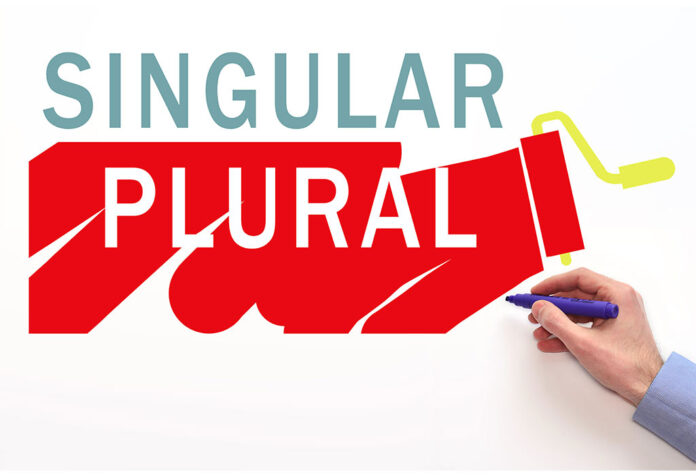English is a language that consists of a plethora of words, both singular and plural. Singular words refer to one object or person, while plural words indicate more than one. Here are 100 examples of both singular and plural words in English:
100 Singular And Plural Words In English
1. Dog – Dogs
2. Cat – Cats
3. Car – Cars
4. Book – Books
5. Table – Tables
6. Chair – Chairs
7. Cup – Cups
8. Spoon – Spoons
9. Pen – Pens
10. Pencil – Pencils
11. Window – Windows
12. Door – Doors
13. House – Houses
14. Tree – Trees
15. Flower – Flowers
16. Phone – Phones
17. Computer – Computers
18. Shirt – Shirts
19. Dress – Dresses
20. Shoe – Shoes
21. Child – Children
22. Person – People
23. Fish – Fish
24. Dish – Dishes
25. Dish (as in a satellite dish) – Dishes
26. Box – Boxes
27. Letter – Letters
28. Bus – Buses
29. Watch – Watches
30. Toy – Toys
31. Baby – Babies
32.Ant – Ants
33. Bee – Bees
34. Cow – Cows
35. Bird – Birds
36. Elephant – Elephants
37. Monkey – Monkeys
38. Lion – Lions
39. Tiger – Tigers
40. Bear – Bears
41. Kangaroo – Kangaroos
42. Sheep – Sheep
43. Goat – Goats
44. Duck – Ducks
45. Goose – Geese
46. Mouse – Mice
47. Rat – Rats
48. Snake – Snakes
49. Fish (different species) – Fish
50. Butterfly – Butterflies
51. Spider – Spiders
52. Horse – Horses
53. Cow – Cows
54. Pig – Pigs
55. Chicken – Chickens
56. Wolf – Wolves
57. Fox – Foxes
58. Squirrel – Squirrels
59. Shark – Sharks
60. Whale – Whales
61. Frog – Frogs
62. Bee – Bees
63. Zebra – Zebras
64.Lizard – Lizards
65. Giraffe – Giraffes
66. Camel – Camels
67. Deer – Deer
68. Rabbit – Rabbits
69. Penguin – Penguins
70. Gorilla – Gorillas
71. Snail – Snails
72. Octopus – Octopuses (or Octopi)
73. Dolphin – Dolphins
74. Crocodile – Crocodiles
75. Rhinoceros – Rhinoceroses
76. Koala – Koalas
77. Ostrich – Ostriches
78. Parrot – Parrots
79. Antelope – Antelope
80. Fox – Foxes
81. Tiger – Tigers
82. Mouse – Mice
83. Vase – Vases
84. Box – Boxes
85. Chair – Chairs
86. Knife – Knives
87. Radio – Radios
88. Tomato – Tomatoes
89. Piano – Pianos
90. Potato – Potatoes
91. Sandwich – Sandwiches
92. Child – Children
93. Foot – Feet
94. Tooth – Teeth
95. Goose – Geese
96. Man – Men
97. Woman – Women
98. Child – Children
99. Leaf – Leaves
100. Sheep – Sheep
These are just a few examples of the countless singular and plural words in English. Learning the distinction between singular and plural words is essential for effective communication in English.
In English, words are classified into two categories: singular and plural. Understanding and correctly using singular and plural words is essential for effective communication. Let’s delve into the details of singular and plural words in English.
Singular Words:
Singular words refer to a single person, thing, or concept. Here are some key points to remember about singular words:
1. Subject-Verb Agreement: Singular subjects require singular verbs. For example: “She walks,” “The bird sings.”
2. Pronouns: Singular nouns are associated with singular pronouns, which include words like “he,” “she,” “it,” and “one.” For example: “He is a doctor,” “She likes to dance,” “It is raining outside.”
3. Determiners and Articles: Singular nouns are typically preceded by determiners such as “a,” “an,” or “the.” For example: “a cat,” “an apple,” “the car.”
4. Possessives: To show ownership or possession with singular nouns, an apostrophe followed by an “s” (‘s) is added. For example: “John’s book,” “the dog’s bone.”
Plural Words:
Plural words refer to more than one person, thing, or concept. Here are some
Important details about plural words:
1. Subject-Verb Agreement: Plural subjects require plural verbs. For example: “They walk,” “The birds sing.”
2. Pronouns: Plural nouns are associated with plural pronouns, such as “they” or “we.” For example: “They are doctors,” “We like to dance.”
3. Determiners and Articles: Plural nouns are typically preceded by determiners like “some,” “many,” or “the.” For example: “some cats,” “many apples,” “the cars.”
4. Possessives: To show ownership or possession with plural nouns, an apostrophe is added after the “s” (s’). For example: “the boys’ toys,” “the dogs’ bones.”
Formation of Plurals:
In English, there are different rules to form the plurals of nouns. Here are some common patterns:
1. Adding -s: Most nouns form the plural by simply adding an -s at the end of the singular form. For example: “book” becomes “books,” “car” becomes “cars.”
2. Adding -es: Nouns ending in -s, -ch, -sh, -x, or -z usually form the plural by adding -es. For example: “bus” becomes “buses,” “box” becomes “boxes,” “church” becomes “churches.”
3. Changing -y to -ies: Nouns ending in -y preceded by a consonant usually change the -y to -ies to form the plural. For example: “baby” becomes “babies,” “city” becomes “cities.”
4. Irregular plurals: Some nouns have irregular plural forms that do not follow any specific pattern. For example: “child” becomes “children,” “man” becomes “men,” “mouse” becomes “mice.”
5. No change: Some nouns have the same form in both singular and plural. For example: “sheep,” “fish,” “deer.”
It is important to note that there are exceptions and irregularities in English language, and memorizing specific plural forms of certain words is often required.
Using correct singular and plural words is essential for precise and clear communication. By understanding the rules and patterns mentioned above, you can effectively use singular and plural words in your English writing and speech.

